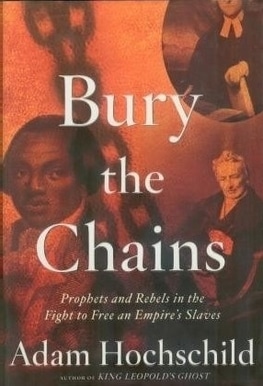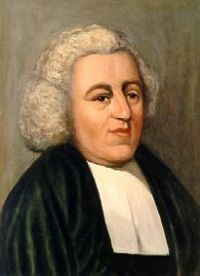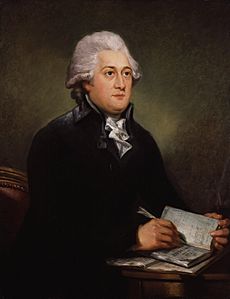Bury the Chains facts for kids

The front cover of the first edition (hardcover)
|
|
| Author | Adam Hochschild |
|---|---|
| Country | United States |
| Language | English |
| Subject | Abolitionism in the United Kingdom |
| Genre |
|
| Publisher |
|
|
Publication date
|
January 7, 2005 |
| Media type | Print (hardcover and paperback), e-book |
| Pages | 480 (2005 US edition) |
| Awards |
|
| ISBN | 978-0-618-10469-7 |
| OCLC | 61299662 |
Bury the Chains: Prophets and Rebels in the Fight to Free an Empire's Slaves is a non-fiction book by Adam Hochschild. It was first published on January 7, 2005. The book tells the story of the anti-slavery movement in the British Empire. This movement happened in the late 1700s and early 1800s.
The book focuses on a group of British people who fought to end slavery. It follows their journey from 1772 until 1838. That's when all British slaves were legally freed. The book shows the challenges these activists faced. It also explains the clever ways they campaigned. Ultimately, they succeeded in ending slavery in Britain.
Hochschild first thought about writing a book about John Newton. Newton was a slave trader who later became an abolitionist. But as Hochschild researched, he learned more about the whole anti-slavery movement. He discovered Thomas Clarkson, an English abolitionist. Clarkson became the main character in the book. Hochschild wanted to highlight Clarkson's important contributions.
Bury the Chains was generally liked by critics. Many praised its exciting and inspiring story. Some felt it didn't go deep enough. A few also thought Hochschild's own views influenced his writing. The book won several awards. These included the 2005 Los Angeles Times Book Prize for History. It also won the 2006 Lionel Gelber Prize. The book has even inspired people working on climate change today. They see similarities between the anti-slavery fight and the climate movement.
Contents
About Bury the Chains
This section explores how the book Bury the Chains came to be. It also introduces the author, Adam Hochschild.
The Author: Adam Hochschild
Adam Hochschild is an American writer. He also helped start a magazine called Mother Jones. Much of his writing looks at unfair historical events. He writes about the people who fought against these wrongs. Hochschild once said he finds it interesting to write about people who risked their lives. They fought against terrible injustice.
Hochschild is known as a popular historian. This means he aims to make history come alive. He does this by focusing on a few people who lived through an event. He doesn't try to offer new historical ideas. His other books include King Leopold's Ghost. That book is about terrible events in the Belgian Congo.
How the Book Was Written

The idea for Bury the Chains started with John Newton. Newton is famous for writing the hymn "Amazing Grace". Hochschild was curious about how Newton changed from a slave trader to an abolitionist. After a few months of research, Hochschild realized something. The real story was about the entire anti-slavery movement, not just Newton.
His research led him to Thomas Clarkson. Clarkson became the main person in Bury the Chains. Hochschild felt that Clarkson's work was often overlooked. Many people focused more on William Wilberforce. Hochschild believed Clarkson was a more interesting person. He wanted to show Clarkson's true importance.
Hochschild also learned that many modern activist groups use methods first used by British abolitionists. These include boycotts, political book tours, and newsletters. They also used petitions, posters, and campaign buttons. They even created national organizations with local groups.
Hochschild spent four years researching and writing the book. He did much of his research in libraries. He also traveled to England and Jamaica. He visited places where the events in the book happened. In London, he saw the site of the bookstore where abolitionists met. In Jamaica, he looked for old sugar plantations. This is where slave rebellions took place.
What the Title Means
The book's title comes from a true story. On August 1, 1838, slavery ended in the British Empire. In Falmouth, Jamaica, a group of freed slaves did something special. They put their slave whip and chains into a coffin. Then, they buried the coffin in a churchyard. This act symbolized burying the chains of slavery forever.
The Story of the Anti-Slavery Movement
Bury the Chains tells the story of the anti-slavery movement in the United Kingdom. It follows a group of British activists. Their successful campaign ended slavery in the British Empire.
Key People in the Movement
The book introduces several important figures:
- Granville Sharp: A unique person who fought for civil liberties.
- Thomas Clarkson: A university graduate who dedicated his life to ending slavery.
- John Newton: A former slave ship captain who became a preacher.
- William Wilberforce: An English politician and friend of the Prime Minister.
- Olaudah Equiano: A former slave who bought his freedom and became a writer.
The Beginning of the Campaign
The book starts by describing slavery in 18th-century Britain. Then, it details how the anti-slavery campaign began. It covers Granville Sharp's efforts to help an African slave named James Somerset in 1772. This led to an important court case, Somerset v Stewart. It also covers the founding of Granville Town, Province of Freedom in 1787.
After this, Thomas Clarkson becomes the main focus. Hochschild explains how Clarkson became passionate about ending slavery. As a student, he researched the topic for an essay. He was so shocked by what he learned that he spent his life fighting slavery. Clarkson found allies in the Quakers, a religious group. One Quaker, James Phillips, owned a bookstore. He agreed to publish Clarkson's essay.
In May 1787, the Society for Effecting the Abolition of the Slave Trade was formed. Both Clarkson and Sharp were founding members. They held their meetings in Phillips's bookstore.
Challenges and Progress

Hochschild describes a difficult period from 1792 to 1802. This was when wars, like the French Revolutionary Wars, slowed down the anti-slavery campaign. But even then, the movement kept gaining support. This was partly thanks to a successful boycott of slave-produced sugar. People like army officer George Pinckard and painter William Blake also spoke out.
Hochschild highlights the vital role of women. Women's societies and activists like Elizabeth Heyrick were very important. These groups shared anti-slavery writings and petitions. They raised money for the cause. They spoke out at public meetings. They also led the sugar boycott. They refused to buy from shops that used or sold slave-produced sugar.
Ending Slavery in Britain
Hochschild explains how the Abolition of the Slave Trade Act 1807 came about. It wasn't just activism. It was also due to national feelings and economic tactics against France. France had brought slavery back under Napoleon.
The Slavery Abolition Act 1833 finally banned slavery in Britain and its colonies. This was possible because of the Reform Act 1832. This act changed many old seats in the House of Commons. Hochschild notes that this act upset some abolitionists. This was because it gave money to slave-owners as compensation. The Abolition Act officially took effect on August 1, 1838. This granted full freedom to all British slaves.

